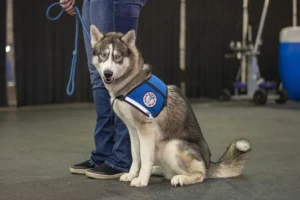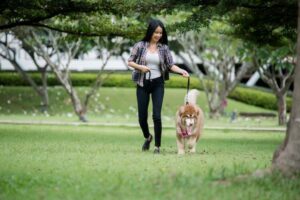What Is Food Aggression?
Food aggression relates to dogs that tend to guard their food from other animals or humans by either growling or snapping at them when they try to take the food away or get too close during feeding time. Some dogs may exhibit this behavior with toys as well, though it is typically associated with meals. A dog exhibiting food aggression usually has their ears pinned back, furrowed brows, and may be snarling or snapping with their jaws.
They aren’t typically known to bite or cause serious damage, but it’s still a potentially dangerous situation for both the dog you are trying to feed as well as any children in the family. If your dog is showing signs of food aggression, you need to act quickly. Be careful when trying to calm your dog because you do not want this behavior to escalate. Here are some tips on how to calm a dog’s aggression with food.

Provide several small meals throughout the day
When your dog is in a calm state, start feeding him smaller meals more frequently. This will help to keep him from getting too hungry during the day while also keeping him at a happier level of hunger rather than having one huge meal that could make him sick if he eats it all at once.
Separate the dogs when feeding time occurs
You may want to separate your dog from any other pets that you have when it is mealtime. This will help ensure that he or she does not get more worked up than necessary and keeps food aggression to a minimum. If one of your other pets has already displayed signs of food aggression, it might be best to keep him in an area where the two animals cannot see each other so that any signs of aggression do not escalate.
Have a special place for your pet’s food bowl
You may want to consider purchasing a dog food dish with a rubber bottom or a raised dish so that it will be harder for other animals or family members to get into your pets bowl while he is eating. Another option would be putting his food in an elevated feeder or one that does not allow the food to come out easily by tipping over. When you put the dish in its spot, say “No” again while scratching your pet on the side of his ear.
Keep all feeding times consistent
If your dog’s mealtimes are always at 6:00pm every day, then stick with that for feeding time regardless of what else might be going on in your life. He needs to understand that this is when he is getting fed and nothing else matters during this time. If he gets too excited and become food aggressive, give him a few minutes to calm down before handing him the bowl; otherwise, take him back to his crate or separate area until he is calm enough that you can put the bowl down without any problems.
Do not leave your dog alone with food
It is never safe to leave your pet alone with any type of food since there are too many accidents that could happen. Make sure you are always around to supervise, even if it means taking turns eating at certain times during the day so each pet gets their own supervised time frame. Otherwise, your other animals may eat all of your dogs food or even try to steal his or her treats, leading to more aggressive behavior from them in return. This makes for a much bigger problem than just trying to feed one pet at a time.
Keep food out of reach
If you are feeding your pet in an elevated feeder, then make sure it is at least 5 feet off the floor to keep other animals away. Keep snacks or treats on top of the refrigerator or other hard-to-reach places that other pets cannot get into easily. It may take some time for your dog to learn these boundaries, but he will eventually understand what is and is not okay when it comes to where his food can be while you are around.
Should you hire a professional trainer to help with aggression?
You don’t have to do it alone! Please don’t let your dog’s behavior get out of hand. Sit Now Stay has the professional trainers that can help with some of your dogs less than perfect behavior. If you are experiencing any strange behavior with your pet it’s never to late to reach out. Contact us today for a free consultation!





